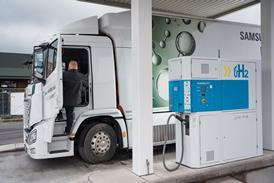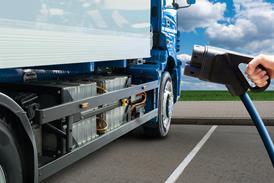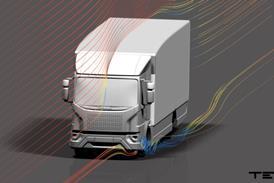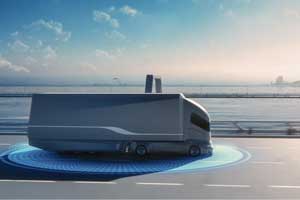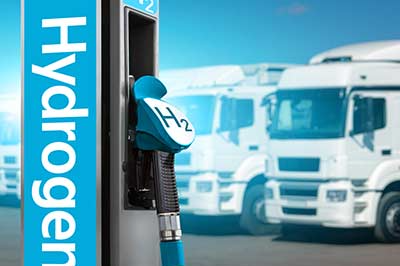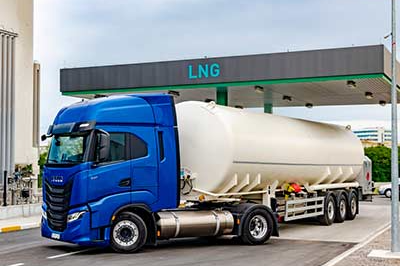
No matter whom you might hear it from, if the technology succeeds at all at mass roll-out, hydrogen is at least a decade behind battery electric technology. That isn’t to say that battery electric trucks have ‘won the race’ just yet, as current thinking on battery electric road freight might be flawed when it comes to achieving a similar total cost of ownership to diesel or gas vehicles.
Let’s talk hydrogen
Leading new energy vehicles writer, Canada-based Michael Barnard, explains: “Every path you go down with hydrogen you hit a dead end, so you go down a different path. Meanwhile, electric motors with their few moving parts keep proving themselves better and better and cheaper and cheaper.”

One area of fuel cell technology that Barnard has highlighted through his writing is that of municipal buses that have trialled hydrogen technology for over a decade. Buses have strong similarities in weight and payload to HGVs. Barnard says: “The data from EU status reports and bus maintenance data out of California are clearly showing that fuel cell buses are less reliable than battery electric or diesel buses.”
The problem is in the complexity of the fuel cell system. Barnard continues: “The more components you’ve got the more there is to fail so it’s impossible not to have more failures if you have more components.”
An unreliable vehicle is going to be costly to run. Prof David Cebon of the Centre for Sustainable Road Freight (SRF) at Cambridge University says that the operating and capital costs of hydrogen vehicles are prohibitive: “The capital cost of a hydrogen vehicle is currently double the cost of an electric vehicle”, which is in turn at least twice that of a diesel vehicle at present.
Where battery electric trucks can conceivably claw that cost back in the low cost of electricity. Cebon continues: “The energy cost of hydrogen vehicles is three times more than EVs, so you put these two numbers in front of an operator they’ll say ‘there’s no way I can afford that!’”
Barnard points out that hydrogen is such a small molecule that leakage is inevitable at all stages of the generation, storage and usage cycle, with up to 20% of the hydrogen produced for fuel lost in the supply chain and usage stages. A 2022 report written by the Universities of Reading and Cambridge for the UK government ‘Atmospheric implications of increased hydrogen use’ observed: “Our estimate of the hydrogen GWP [global warming potential] for a 100 year time horizon is 11±5, which is more than 100% than previously published calculations.” CO2 has a GWP potential of 1, so hydrogen is up to 16 times as bad for the climate as CO2. The solution they called for is to minimise leakage, but with hydrogen the second smallest molecule in the universe, this is next to impossible.
Cebon says: “Hydrogen for trucking is a dead duck!”
Battery electric - the race isn’t won
Despite the US and Japan going big on hydrogen, as a genuinely green technology it is struggling even in infancy. Has battery electric won the race in road freight then? Not quite.
Cebon explains that if we have a scenario where trucks are charged at depots, warehouses and on motorway service areas, fleet sizes are going to be much larger to achieve the same output as we have in today’s largely diesel fleet. “There are about 200,000 articulated HGVs on the road today,” he says. “If they were all EVs with big batteries, about 40,000 of these would have to be stopped at any one time, charging.
“That would require 40,000 charging/parking spaces, each of which is 10 times the area needed to charge/park a car. That space simply doesn’t exist in the UK at the moment.”

Charge point providers (CPPs) Gridserve and Milence among others are planning to provide public truck charging stations along the strategic road network but even if they achieved 40,000 spaces, Cebon raises another problem: “If you have to stop a truck to charge for an hour after every four that you wouldn’t on a diesel truck, it will cost you 20% more to transport the same goods. A trucking company’s operating margins are typically 3%.”
If 20% added costs aren’t off-putting enough, Cebon adds: “At the moment a 6-axle, 44-tonne truck can carry 29 tonnes of payload but your 5-axle, 42-tonne battery electric truck can carry 22 tonnes, 7 tonnes less than a diesel truck. Across the fleet that means more about 20% more vehicles, and with the added trucks to compensate for time spent charging, you end up with logistics costs of the order of 30% to 40% higher than you have at present.”
A consortium including the SRF, Arup and Costain wrote a report pointing out these issues to the UK government, concluding that on-road ‘dynamic’ charging is the only way to get around these issues. Even though the government commissioned the report it refused to publish it. In Cebon’s opinion, the UK is going down a dead-end street with the current thinking on decarbonising road transport.
Warehouse charging?
Under this current thinking, one of the key ways to reduce battery size in trucks would be to have warehouse charging while trucks are loaded and unloaded. This would add complexity to the supply chain as the warehouse would charge operators for ‘fuel’ when it normally pays them to carry its goods.
Most warehouses would also need large new electricity connections to the grid to handle this extra load. Cebon points out: “It’s fine to put a couple of chargers into a depot as happens now. But we have to decarbonise the whole logistics system and that means every truck. To get to that point our research indicates that it will be necessary to install 4MW to 20MW grid connections in 10,000 to 20,000 warehouses and logistics facilities around the UK. That is a huge challenge.”
FCZ approached the Energy Networks Association which represents the UK’s distribution network operators (DNOs) and National Grid Energy Distribution to see if they had any hard figures on the costs involved for a logistics operator to get an extra 10MW connection. Neither were willing to be interviewed on the matter and in statements did not offer any idea of the costs. Cebon says: “I don’t think that National Grid and the DNOs know that this problem exists. They don’t know that it’s essential to charge trucks at warehouses.
“The alternative of charging in public facilities is that trucks need much larger batteries; the amount of truck parking/charging spaces required at truck stops is enormous; and logistics costs increase substantially because of the additional time needed to charge batteries during journeys.”
Motorway charging
Again, under current government thinking, HGVs will still need to be charged at service stations on the strategic road network. According to the theory, a truck would get a high-powered charge under the newly agreed megawatt charging system (MCS) protocol that can put up to 1MW of power into a battery, allowing for a shorter stop. MCS chargers are being trialled by Electric Freightway, one of the four Zehid zero emission demonstrator projects supported by the DfT through Innovate UK.

UK national CPP Gridserve is one of the participants. They were also approached but as the Electric Freigtway trial is just getting underway Gridserve felt it couldn’t contribute much about total cost of ownership. What is known is that for smaller electric vehicles, on a public rapid charger of up to 350kW, the electricity is charged at £0.79/kWh. For private EV users this is extremely expensive on vehicles that get 3.25 miles per kWh, which translates to around 30p per mile, or three times that of diesel. HGVs would fare better as typically they consume 1kWh per mile (though much more with a full load) and this may end up cheaper than diesel on present prices. It’s nowhere near the promised land of lower energy costs compensating for sky high capital costs, and CPPs are likely to charge much more for megawatt chargers.
Dynamic charging
Dynamic charging essentially involves trucks being powered as they use the strategic road network. This could be overhead cables - something National Highways has raised issues with - or in-road charging. The eHGV would be powered on the road and need a far smaller battery to travel the last say 30 miles to a depot. Instead of having to carry a battery capable of 350 miles per charge, it might only require 20% of that range for normal use.
With batteries the most expensive component, TCO would plummet. On the TCO front, Cebon says: “In 2035 we calculate that a 1.2MWh battery won’t reach cost parity with diesel. As you get down to vehicles with smaller batteries, charged dynamically in motion, you get significantly cheaper than diesel.” Cebon claims around 20% lower TCO, adding: “With dynamic charging, there is no weight or time penalty, meaning logistics costs equal to diesel.”
With dynamic charging, rather than logistics costing more, Cebon suggests that, with “a lower TCO there is headroom for the government to raise tax and make some of the money back that they will lose on diesel excise duty”. The dream of TCO being low enough that sustainable transport contributes to society in taxes would be achieved.
The 20,000 warehouses wouldn’t need that expensive 10MW connection or have to charge their transport company for electricity. The electricity network wouldn’t be so stretched in this scenario, as the electricity supply would be along major A roads and motorways where National Grid already has a strong network.
Many European and Scandinavian countries are actively considering dynamic charging and only the UK government, Cebon says, “has its head in the sand”. This could be a problem for the UK as, Cebon continues, “if there is dynamic charging in Europe, the UK will have no choice. If trucks are dynamically charged in France or the Netherlands they wouldn’t be able to cross the Channel and cross-Channel logistics is essential, not optional,” concluding, “the UK government needs to be engaged in the discussion, trialling the technologies and getting ready for dynamic charging. Because if it comes from Europe, the UK will have to fall into line - it won’t have a choice”.
A long road ahead?
Battery electric may well have already won the race for private cars. Battery costs are falling and energy density is growing, making batteries for zero emission light road transport an inevitability. For HGV fleets, however, batteries don’t quite add up yet. Could the solution be to power HGVs on the road? If this is the answer, we need the UK government to join the conversation that our neighbours in Europe are already having. If we don’t we might yet have the solution given to us whether we like it or not. In or out of Europe politically, our supply chains are still inextricably linked to it.

